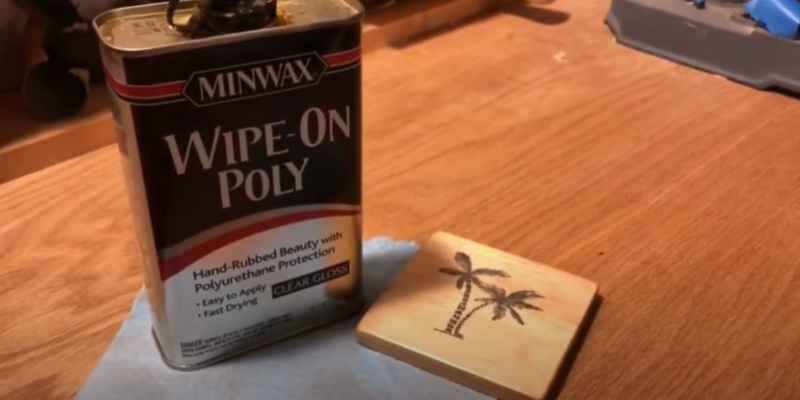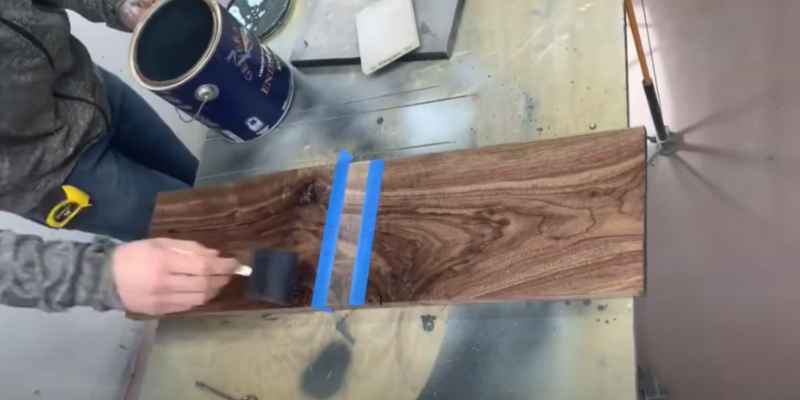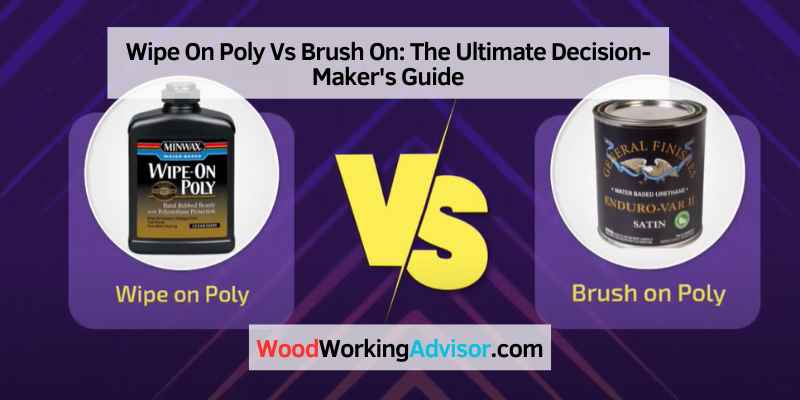Wipe on poly provides a smoother and more even finish compared to brush on poly, but brush on poly offers greater control and precision during application. Wipe on poly and brush on poly are two popular methods for applying polyurethane finishes to wood surfaces.
Wipe on poly provides a smoother and more even finish due to its thin consistency, which allows the polyurethane to penetrate the wood fibers more effectively. On the other hand, brush on poly offers greater control and precision during application, making it ideal for intricate or detailed work.
Both methods have their advantages and it ultimately depends on the specific project and personal preference.
What Is Wipe On Poly?
Wipe On Poly is a type of polyurethane finish that provides a durable protective layer to wood surfaces. Unlike traditional polyurethane, which is typically applied with a brush, Wipe On Poly is designed to be applied by simply wiping it onto the wood using a cloth or applicator pad.
Benefits Of Wipe On Poly
1. Easy Application: Wipe On Poly eliminates the need for brushes or special tools, making it incredibly easy to apply. Even for beginners, achieving a smooth and flawless finish is a breeze.
2. Time-Saving: Wipe On Poly dries quickly due to its thin consistency, allowing you to finish your project in less time. With no brush marks to worry about, you can achieve a professional-looking finish in no time.
3. Versatility: Whether you’re working on large or intricate pieces, Wipe On Poly can be applied to both smooth and detailed surfaces with ease, ensuring even coverage and protection.
Drawbacks Of Wipe On Poly
1. Limited Build: Due to its thin consistency, Wipe On Poly may not build up as much as brush-on polyurethane. This means that if you require a thick protective layer or high-gloss finish, brush-on polyurethane may be a better choice.
2. More Coats Needed: While Wipe On Poly is easy to apply, it may require multiple coats to achieve the desired level of protection and durability. This can make the process more time-consuming compared to brush-on polyurethane, which often requires fewer coats.
3. Not Suitable for Large Surfaces: If you’re working on large surfaces like hardwood floors or tabletops, the application of Wipe On Poly may be more time-consuming and labor-intensive compared to brush-on polyurethane. The large surface area requires continuous wiping, which can be tiring and less efficient.
In summary, Wipe On Poly offers easy application and quick drying time, making it an ideal choice for smaller woodworking projects. However, it may not be suitable for those looking to achieve a thick protective layer or working on large surfaces. Understanding the benefits and drawbacks of Wipe On Poly can help you make an informed decision when choosing a polyurethane finish for your woodworking projects.

What Is Brush On Poly?
When it comes to wood finishing, one popular option is polyurethane. There are two main ways to apply polyurethane: wipe on and brush on. In this blog post, we will explore the benefits and drawbacks of brush on poly, starting with the question: What is Brush On Poly?
Benefits Of Brush On Poly
Using brush on polyurethane for your wood finishing projects offers several advantages:
- Versatility: Brush on poly can be used on a variety of wood surfaces, including furniture, cabinets, and floors.
- Better Coverage: By applying the polyurethane with a brush, you can achieve a more even and complete coverage compared to wipe on poly.
- Thicker Coats: Brush on poly allows you to build up thicker coats, providing enhanced protection and durability for your wood.
- Faster Application: Using a brush typically speeds up the application process, allowing you to finish your project in less time.
- Seamless Touch-Ups: If you need to touch up or repair a coated area, brush on poly makes it easier to seamlessly blend the new layer with the existing finish.
Drawbacks Of Brush On Poly
While brush on polyurethane has its advantages, it also comes with some drawbacks:
- Visible Brush Marks: Since you are applying the polyurethane with a brush, there is a higher chance of leaving visible brush marks on the finished surface.
- Drying Time: Brush on polyurethane tends to have a longer drying time compared to wipe on poly, which may prolong the completion of your project.
- Cleanup: Using a brush for application requires thorough cleaning afterward, which can be more time-consuming.
- Bubbles and Bristle Marks: If not applied carefully, brush on poly may leave behind bubbles or bristle marks, requiring additional sanding or touch-ups.
Comparison Of Wipe On Poly And Brush On Poly
When it comes to choosing the right polyurethane finish for your woodworking projects, two common options are wipe on poly and brush on poly. Both of these finishes provide a protective coating for your wood, but they differ in terms of application process, level of finish, durability, and ease of use. In this article, we will compare these two types of polyurethane finishes to help you make an informed decision.
Application Process
The application process for wipe on poly and brush on poly is where the main difference lies. Wipe on poly is exactly as it sounds – you simply apply the finish by wiping it onto the surface of the wood using a cloth or sponge. This method allows for more control over the amount of finish being applied and helps to minimize drips and brush marks.
On the other hand, brush on poly requires the use of a brush to apply the finish. This method can be a bit trickier, especially for beginners, as it is easier to accidentally apply too much finish or leave behind brush strokes. However, with practice and the right technique, you can achieve a smooth and even finish using a brush.
Level Of Finish
When it comes to the level of finish, both wipe on poly and brush on poly can provide a professional-looking result. However, wipe on poly tends to have a more subtle sheen and is better for achieving a natural or vintage look. The thin coats of wipe on poly allow the wood’s natural beauty to shine through, while still providing adequate protection.
Brush on poly, on the other hand, tends to create a thicker and glossier finish. This makes it more suitable for high-traffic areas or projects that require a more durable and shiny finish, such as tabletops or kitchen cabinets.
Durability
In terms of durability, both wipe on poly and brush on poly offer good protection for your wood projects. However, brush on poly generally provides a slightly tougher and more durable finish. The thicker coats of brush on poly can resist minor scratches and wear better over time, making it a better choice for projects that will undergo heavy use.
That being said, wipe on poly is still a durable option and can provide adequate protection for most woodworking projects. It ultimately depends on the specific needs of your project and the level of wear and tear it will endure.
Ease Of Use
When it comes to ease of use, wipe on poly takes the lead. It is a beginner-friendly option that requires minimal equipment and can be easily applied without much experience. With wipe on poly, you have more control over the application process and can correct any mistakes or drips more easily.
Brush on poly, on the other hand, requires a bit more skill and practice to achieve a smooth and professional finish. It can be more challenging for beginners and may require some sanding or buffing to achieve the desired result.
In conclusion, both wipe on poly and brush on poly have their own advantages and it ultimately boils down to your specific project requirements and personal preference. If you need a more natural or vintage look, opt for wipe on poly, whereas brush on poly is better suited for projects that require a thicker and glossier finish with higher durability. Whichever option you choose, following proper application techniques will help you achieve a beautiful finish on your woodworking projects.
Factors To Consider When Choosing Between Wipe On Poly And Brush On Poly
Choosing between wipe on poly and brush on poly requires careful consideration of various factors. These include the level of durability desired, ease of application, desired finish quality, and the type of project being undertaken. By assessing these factors, individuals can make an informed decision on which type of poly to use.
Factors to Consider when Choosing between Wipe On Poly and Brush On Poly
When it comes to choosing between wipe on poly and brush on poly for your next project, there are several factors to consider. The project type and size, time constraints, skill level, and budget will all play a role in determining which option is best for you. Let’s take a closer look at each of these factors to help you make an informed decision.
Project Type And Size
The first factor to consider is the project type and size. Wipe on poly is a great choice for smaller projects, such as furniture refinishing or touch-ups. Its thin consistency allows for easy application on intricate details and hard-to-reach areas. On the other hand, brush on poly is better suited for larger projects that require a more even and consistent finish, such as hardwood floors or wooden fixtures. Using a brush allows for better control and coverage on larger surfaces.
Time Constraints
Time constraints are another important consideration. If you’re working on a project with a tight deadline, wipe on poly can be a time-saving option. It dries faster than brush on poly, allowing you to apply multiple coats in a shorter period of time. Additionally, wipe on poly requires minimal sanding between coats, further reducing the overall time required to complete your project. However, if you have more time to spare and are willing to invest additional effort, brush on poly can provide a more durable and professional-looking finish.
Skill Level
Consider your skill level when choosing between wipe on poly and brush on poly. Wipe on poly is generally more beginner-friendly, as it is easier to apply and produces fewer visible brush marks. It requires less precision and technique, making it a great option for DIY enthusiasts or those who are new to woodworking. Brush on poly, on the other hand, requires a bit more skill and practice to achieve a smooth and flawless finish. If you have experience with brushing techniques or are willing to put in the time to master it, brush on poly can yield impressive results.
Budget
Last but not least, your budget will influence your decision. Wipe on poly is typically more cost-effective, as it requires less product and equipment. You can achieve great results with just a cloth or sponge applicator, minimizing the need for expensive brushes or sprayers. Brush on poly, on the other hand, may require additional investment in high-quality brushes to achieve a professional finish. Take into account your available budget and consider the long-term benefits of each option before making a decision.
In conclusion, when choosing between wipe on poly and brush on poly, consider the project type and size, time constraints, skill level, and budget. Each option has its own advantages and is suited to different scenarios. By evaluating these factors, you can make a decision that aligns with your needs and ensures the best possible outcome for your project.
Making The Ultimate Decision
Deciding between Wipe On Poly and Brush On poly can be a tough choice. Both options have their own advantages and disadvantages, and making the right decision can ensure a smooth and successful finishing project. To help you make an informed choice, here are a few important factors to consider.
Assessing Your Needs
Before diving into the decision-making process, take a moment to assess your specific needs and requirements. This will help you evaluate which type of polyurethane finish will best suit your project. Consider the size and nature of the surface you’re working on, the desired level of protection, and your personal preferences.
Testing And Experimentation
Once you have assessed your needs, it’s time to put both Wipe On Poly and Brush On Poly to the test. Conducting some experimentation will allow you to see firsthand how each type of polyurethane finish performs on your chosen material. Create small test samples and apply both finishes, paying attention to factors such as ease of application, coverage, and overall appearance.
By experimenting, you can gain valuable insights that will help you make an informed decision based on practical results rather than speculation or assumptions.
Consulting Experts
When in doubt, seeking guidance from experts in the field can provide invaluable advice. Woodworking forums, online communities, and local experts can offer insights based on their experience working with different finishing products. Share your specific requirements and get recommendations from those who have already tackled similar projects. This will help you gather different perspectives and make a more informed decision.
Considering Long-term Maintenance
One often overlooked aspect of the decision-making process is long-term maintenance. While both Wipe On Poly and Brush On Poly offer durable protection, the level of maintenance required can vary. Consider factors such as ease of reapplication, resistance to wear and tear, and the need for additional protection over time.
Think about the long-term implications of your choice and whether you are prepared to put in the necessary effort for upkeep. This will help you avoid any surprises down the line and ensure your finished project continues to look its best for years to come.

Frequently Asked Questions Of Wipe On Poly Vs Brush On
What Are The Disadvantages Of Wipe On Polyurethane?
The disadvantages of wipe-on polyurethane include longer application time, potential for streaking or uneven finish, and less durability compared to brush-on or spray-on polyurethane. It may also require multiple coats for proper protection, increasing the overall time and effort required for the application process.
Can I Use Wipe-on Poly Over Brush On Poly?
Yes, you can use wipe-on poly over brush-on poly.
How Durable Is Wipe-on Poly?
Wipe-on poly is highly durable, providing long-lasting protection to surfaces. It is a reliable choice for furniture, floors, and other wooden items. Its application is easy and gives a smooth finish. Wipe-on poly offers excellent resistance to wear, water, and chemicals, ensuring the durability of your project.
What Is Different About Wipe-on Poly?
Wipe-on poly is a type of finish that can be easily applied by wiping it onto the surface. It saves time and effort compared to traditional brush-on polyurethane. It gives a smooth, even finish and is great for smaller projects or touch-ups.
Conclusion
To sum it up, the choice between wipe-on poly and brush-on poly ultimately comes down to personal preference and the specific project at hand. Both methods have their advantages and disadvantages, offering different levels of ease, durability, and finish. Consider the type of wood, desired sheen, and your own comfort level with application techniques.
With careful consideration, you can achieve the desired results and protect your wood surfaces effectively.


